How This Brand Guidelines Template Can Quickly Increase Your Health Practice’s Online Appeal

Standing out online takes more than just a unique logo or a catchy tagline for your health or wellness practice. It requires an immersive brand experience capable of setting you apart and connecting with potential patients or clients on a deeper level. By using our brand guidelines template, you’ll have the foundation to create this type of experience and significantly enhance your practice’s online appeal.
Although it may sound complicated, the journey to a compelling brand doesn’t have to be. With the right brand guidelines template and insights on how to use it effectively, the process of transforming your online presence can be swift and straightforward.
Why Brand Guidelines Matter
Brand guidelines aren’t just a nice-to-have. They’re a must for every health or wellness practice. Picture them as your brand’s blueprint, guiding everything from your logo placement to the colors you use. It’s all about consistency—and that consistency builds recognition, trust, and ultimately, a solid online presence.
Think of your brand guidelines as your visual content’s best friend. Each image, infographic, or video is an opportunity to amplify your brand. Your brand guidelines ensure they all tell the same story, leading to a unified, more appealing online image.
Whether you have a marketing team or you’re personally managing all of your marketing, with a well-crafted brand book, every campaign and piece of online content will be in harmony with your brand. This cohesive approach strengthens your brand identity, making your online presence hard to miss.
So, we see brand guidelines are powerful—but to harness that power, you need a robust brand guidelines template. Let’s explore that next.
Exploring the Brand Guidelines Template
A well-crafted brand guidelines template is like a compass—it helps you navigate the complexities of brand-building with clarity and direction. (Download a copy of our brand guidelines template so you can easily follow along with the following discussion.)
Let’s take a deep dive into our brand guidelines template and how you can use it to reflect your unique health practice.
Brand Story and Personality
This section is all about your brand’s heart. It covers your mission, vision, and values, the stories that inspired your practice, and the personality you want to convey. In essence, it’s the backbone of your brand that will resonate with your audience.

Logo Usage
Your logo is the face of your brand. Here, you’ll define its proper usage—where and how it should be displayed, acceptable variations, and improper uses to avoid. Remember, consistency is key!
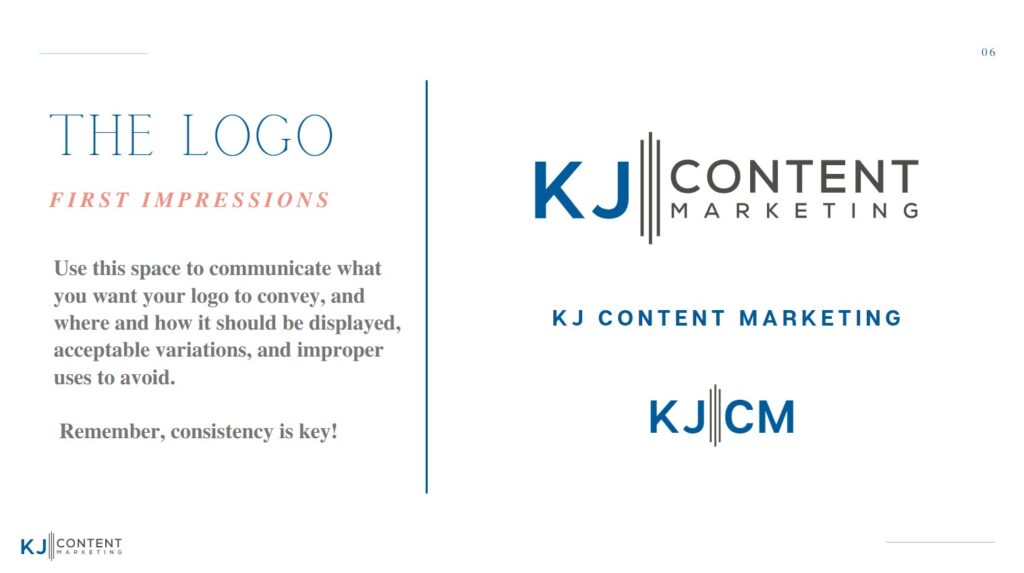
Color Palette
Colors evoke emotions and play a crucial role in how your audience perceives your brand. This section outlines your primary and secondary color schemes. Having clear guidelines ensures your colors stay true across all mediums.
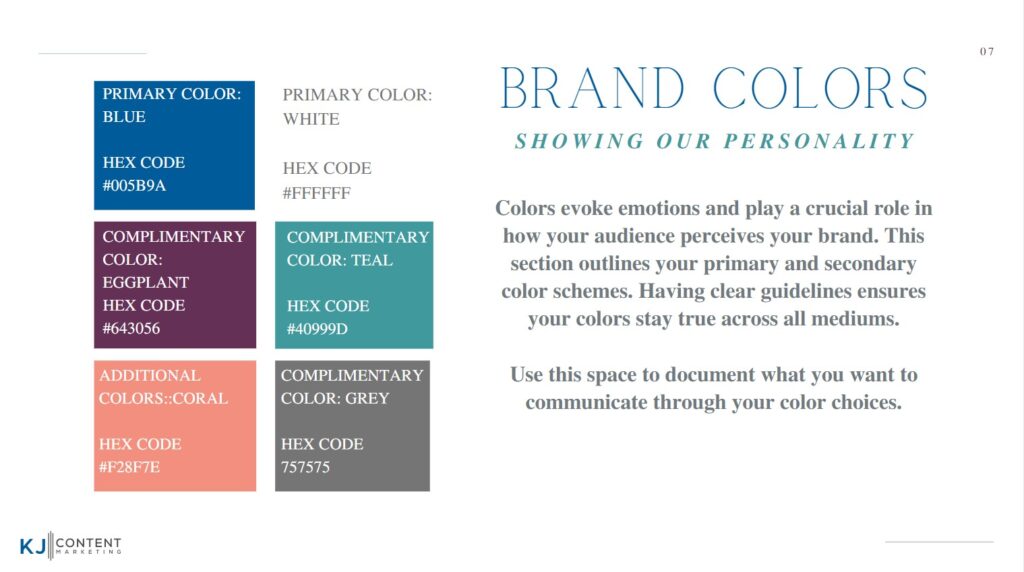
Typography
This portion is dedicated to fonts—the styles, sizes, and spacing to be used in your brand materials. Like colors, fonts should be consistent and align with your brand’s mood.
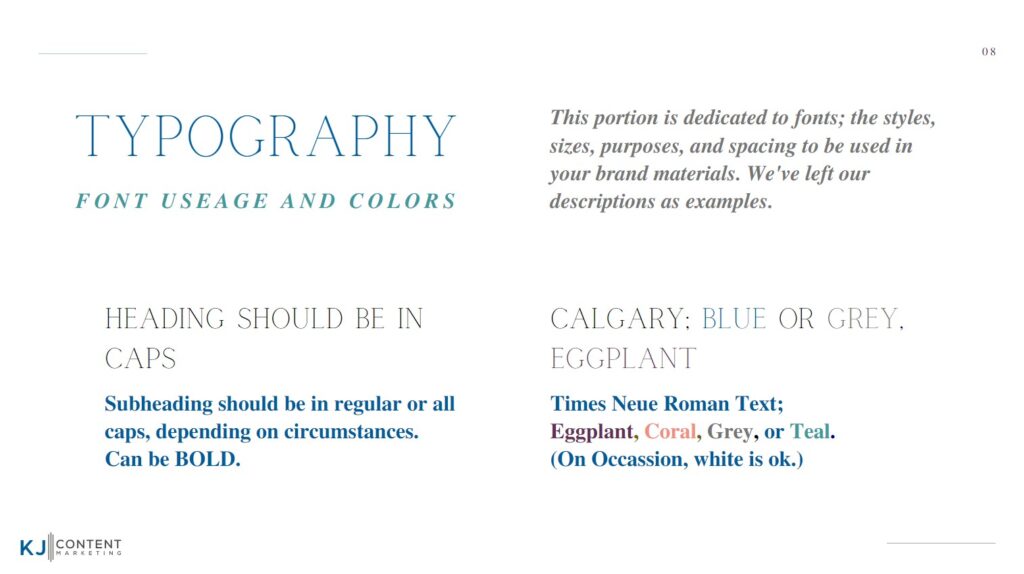
Imagery and Visual Elements
This section guides the selection and use of images, infographics, icons, and other visual elements. Having clear guidelines helps maintain a consistent visual identity that complements your brand.
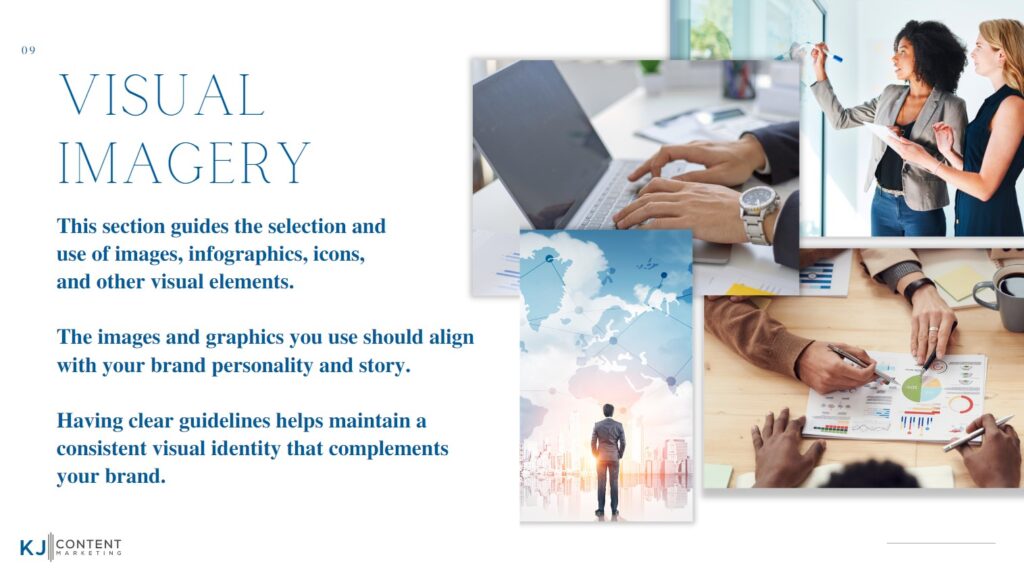
Voice and Tone
Your brand isn’t just seen; it’s heard. This part focuses on the language style, tone, and vocabulary that reflects your brand’s personality in written and spoken communications.
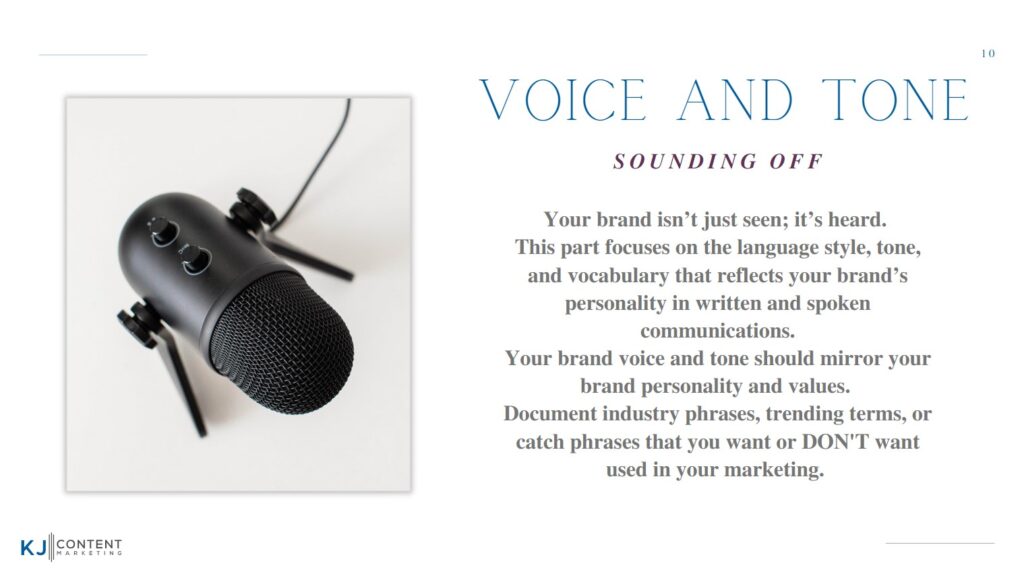
Now that we’ve laid out the sections, let’s look at a hypothetical case study to see this template in action.
A Hypothetical Case Study: Implementing the Brand Guidelines Template
Let’s consider a hypothetical health practice, “Wellbeing Therapy Center” (WTC), specializing in holistic wellness therapies. Their team and services are top-notch, but their online presence lacks consistency. In a situation similar to what many of our actual clients have faced, they’ve decided to use our brand guidelines template to bring cohesiveness to their brand.
Here’s how WTC completed the template:
Brand Story and Personality
WTC’s mission is to promote holistic wellness, and their brand personality embodies calming, knowledgeable, and supportive traits. They envision their brand as a trusted wellness partner.Logo Usage
WTC’s logo, a symbolic representation of a tree and human figure, should always appear in the top left of their communications, preserved in its original colors, and never be distorted.Color Palette
Earthy greens and blues, symbolizing nature and tranquility, make up their primary colors. The secondary palette includes soft neutrals, creating a calming, warm atmosphere.Typography
For a blend of trustworthiness and friendliness, WTC goes with a clean, readable serif font for headings and a friendly sans serif for body text.Imagery and Visual Elements
The chosen images exude calm and serenity, with a focus on nature and tranquil environments. The infographics are kept simple and clean, presenting clear information about various therapies.Voice and Tone
WTC’s voice is caring and knowledgeable, and the tone is consistently supportive and reassuring. They prioritize clarity over jargon to keep their communication accessible.
By applying these guidelines, WTC can achieve a unified, resonating brand, effectively boosting their online appeal. Although WTC is a representative example, their story echoes the real transformation we’ve seen our clients experience when they effectively implement brand guidelines.
Tailoring the Brand Guidelines Template to Your Health Practice
Creating effective brand guidelines isn’t a one-size-fits-all process. It requires careful thought, introspection, and understanding of your unique brand. Below, we’ll guide you through adapting our brand guidelines template to your health practice.
Brand Story and Personality
Start by diving deep into your brand’s core. Consider questions like:
What drove you to start your practice?
What are your guiding values and principles?
What impact do you aim to have on your clients’ or patients’ lives?
Your answers will shape your brand story and personality. Remember, authenticity is key. You want your audience to connect with the real you.Logo Usage
Your logo is much more than a pretty image. It’s a visual representation of your brand.
When defining its usage, consider its placement, size, color variations, and what constitutes improper usage. Your logo should always be recognizable and used consistently.Color Palette
Colors can stir emotions and drive perceptions. And, as a colleague of mine is fond of saying, “Perception drives reality.” So, you’ll want to be thoughtful as you select your color palette.
What feelings do you want to evoke when someone interacts with your brand? Tranquility? Energy? Optimism?
Choose your primary and secondary color schemes to reflect these emotions and ensure they are consistently used across all platforms.Typography
Your typography should complement your brand personality. A serious, traditional brand might opt for classic serif fonts, while a more modern, friendly brand might go for a clean sans serif. Make sure to specify the font styles, sizes, and spacing to maintain consistency.Imagery and Visual Elements
The images and graphics you use should align with your brand personality and story. They can range from photos of your practice to infographics of your services to images for your blogs and social posts. You’ll want them to feel consistent in style for a coherent visual identity.Voice and Tone
Your brand voice and tone should mirror your brand personality and values. If you’re a vibrant, energetic brand, your language can be more informal and lively. If you’re more reserved and professional, your language should reflect that. Specify this in your guidelines to ensure consistent communication.
Remember, your brand guidelines should evolve as your practice grows and changes. They aren’t set in stone but should serve as a solid foundation for your brand.
The Potential Impact of Brand Guidelines on Your Health Practice’s Online Appeal
Well-crafted brand guidelines can positively impact your practice’s online appeal in a lot of different ways.
When you maintain branding consistency, you enhance brand recognition and instill trust in your audience. By adhering to a uniform style, color scheme, voice, and imagery, your content becomes instantly identifiable as yours, enhancing your online visibility, driving traffic to your website, and growing your practice.
An online presence that reflects cohesiveness and thoughtfulness speaks volumes about your professionalism, potentially attracting more clients or patients, and partners.
Your brand guidelines should highlight your uniqueness – what makes you different from your competitors. By spotlighting what sets your services, approach, and values apart, your brand guidelines can help you carve out your unique identity which will resonate with your ideal patients and clients.
If you operate with a team, having these guidelines ensures everyone is aligned in content creation, client communication, and representation of your practice. This unity in your branding efforts could foster a more effective team and a stronger brand.
With clear guidelines, you can eliminate guesswork from your branding decisions. From website design to social media content creation, having a reference point can make the process more efficient and coherent.
Applying Your Brand Guidelines Across Your Online Platforms
Now that you’ve crafted your detailed brand guidelines, it’s time to put them into action across your digital presence. Here are some tips to help you integrate your brand’s unique identity into the various online platforms that most health and wellness practices use:
Website
Your website is usually the first online impression potential clients or patients have of your practice. It’s critical that it be in line with your brand guidelines. This includes the color scheme, typography, imagery style, and tone of voice.
You’ll also want to display your logo prominently and ensure your brand story is woven throughout.Blog
Blogs are a great way to display your brand’s personality and expertise. The topics you choose to post about, tone of writing, and image style should all reflect your brand guidelines.
Consistently posting will also strengthen your brand identity and establish you as a field authority.Social Media
Social media is a great way to engage with your audience on a more personal level. Everything from your posts, comments, profile images, to responses to followers should align with your brand guidelines. Consistency across platforms builds recognition and trust which is a key factor in people wanting to use your services.Email Marketing
Every email you send, which includes newsletters, invoices, and promotional emails, is a chance to reinforce your brand identity. It should mirror your brand’s aesthetic and tone, making your identity even more familiar to your clients.Online Advertising
If you’re running online ads, they should feel and look like a part of your brand. This consistency will help your audience recognize your ads quickly, which will improve the chances of interaction.Video Content
Videos offer a unique opportunity to bring your brand’s personality to life. Whether it’s an informational video or a promotion, make sure it’s aligned with your brand guidelines.
Implementing your brand guidelines across all online platforms not only reinforces your brand identity but also provides clarity and direction. However, remember that guidelines are just that—a guide. They’re the foundations, but there’s always room for creativity and adaptation as your brand evolves.
Evolving Your Brand Guidelines
Growth is the natural course for any thriving health and wellness practice. As your practice evolves and matures, your brand guidelines will naturally need to evolve as well. Let’s consider the journey of the “Wellbeing Therapy Center”.
When the “Wellbeing Therapy Center” first created their brand guidelines, they had a clear image of their brand identity. However, as they grew, so did their understanding of their practice’s personality and audience. Their initial choice of bright, energetic colors had worked well to draw in a younger audience. However, they started noticing an increase in older clients, who appreciated a more serene and calming color palette.
Recognizing this shift, the “Wellbeing Therapy Center” made a subtle, but effective adjustment to their brand guidelines. They kept their primary color scheme but introduced a set of secondary colors that were softer and more soothing.
In addition to this, they noticed a growth in their online traffic from their blog and social media platforms. So, they revised their content strategy, adjusting their tone and language to speak more directly to their expanding demographic. They also updated their brand rules around visuals on these platforms to ensure consistency and relevancy to their diversified audience.
This example shows how the “Wellbeing Therapy Center” remained flexible and adapted their brand guidelines as their practice evolved. It’s crucial to remember that brand guidelines are not set in stone but are a living document that grows and evolves with your practice.
So, regularly review your brand guidelines and don’t be afraid to make tweaks and changes when necessary. The most important thing is to remain true to your core brand identity while still catering to your growing and evolving clientele.
Up next, we’ll talk about how to keep your brand guidelines fresh and alive.
Keeping Your Brand Guidelines Alive
After you’ve crafted your brand guidelines, it’s vital to keep them alive and vibrant. This isn’t a document that you create, use once, and then forget. It should be a living, breathing part of your health and wellness practice.
Here are a few ways to ensure your brand guidelines stay fresh:
Regular Reviews: Schedule regular review sessions for your brand guidelines. Maybe you do this quarterly, or perhaps it’s best done annually. Use these reviews to assess what’s working and what needs to be updated.
Educate Your Team: If you have a team, make sure they’re familiar with your brand guidelines. Hold workshops or training sessions to ensure everyone understands the guidelines and why they’re important. The more your team knows the more they can help your brand’s identity stay consistent and powerful.
Apply Them Consistently: The best way to keep your brand guidelines alive is to use them. Every piece of content, every social media post, every interaction with clients – they should all reflect your brand guidelines. Consistency helps keep your brand identity strong.
Allow for Evolution: Don’t be afraid to let your brand guidelines evolve. As we discussed earlier, your practice will change and grow, and so should your brand guidelines. Stay flexible and willing to adjust as needed.
Keeping your brand guidelines alive is all about commitment. It’s about recognizing the power of a strong, consistent brand identity and committing to maintaining and enhancing it.
In the next section, we’ll conclude our discussion on how a brand guidelines template can bolster your health practice’s online appeal.
Amplify Your Online Appeal with a Brand Guidelines Template
A well-defined brand guideline is more than just a document; it’s the DNA of your health and wellness practice. It sets the tone, personality, and the visual identity that connects with your audience on a deeper level. Crafting and using a brand guidelines template can have a transformative impact on your online presence, giving your practice a distinctive and attractive appeal.
Delving into the elements of brand guidelines, their real-world applications, and strategies to keep them relevant, we’ve uncovered the profound impact they can have on a practice’s digital persona. A representative case study of “Wellbeing Therapy Center” brings to life the potential of a well-thought-out brand guideline.
Remember, your brand guideline isn’t static. As your practice evolves, your brand guidelines will naturally need to evolve too, flexing and adapting to the rhythm of your business and its growing audience.
Brand guidelines are the cornerstone of your online appeal, infusing consistency and professionalism into every interaction with your audience. They also pave the way for your brand’s future growth, serving as a compass for every content piece you create and every decision you make about your brand’s image.
Embarking on the journey to create and implement your brand guidelines is a worthwhile venture, one that can significantly enhance your practice’s online appeal and foster stronger, more meaningful relationships with your clients.
The exciting part is, you’re not alone on this journey. We have an experienced team of branding experts ready to guide you every step of the way. If you’re eager to amplify your practice’s online appeal or need some support in developing your brand guidelines (don’t forget to download a copy of our brand guidelines template), schedule a free consultation today. Together, let’s make your unique brand truly shine!
